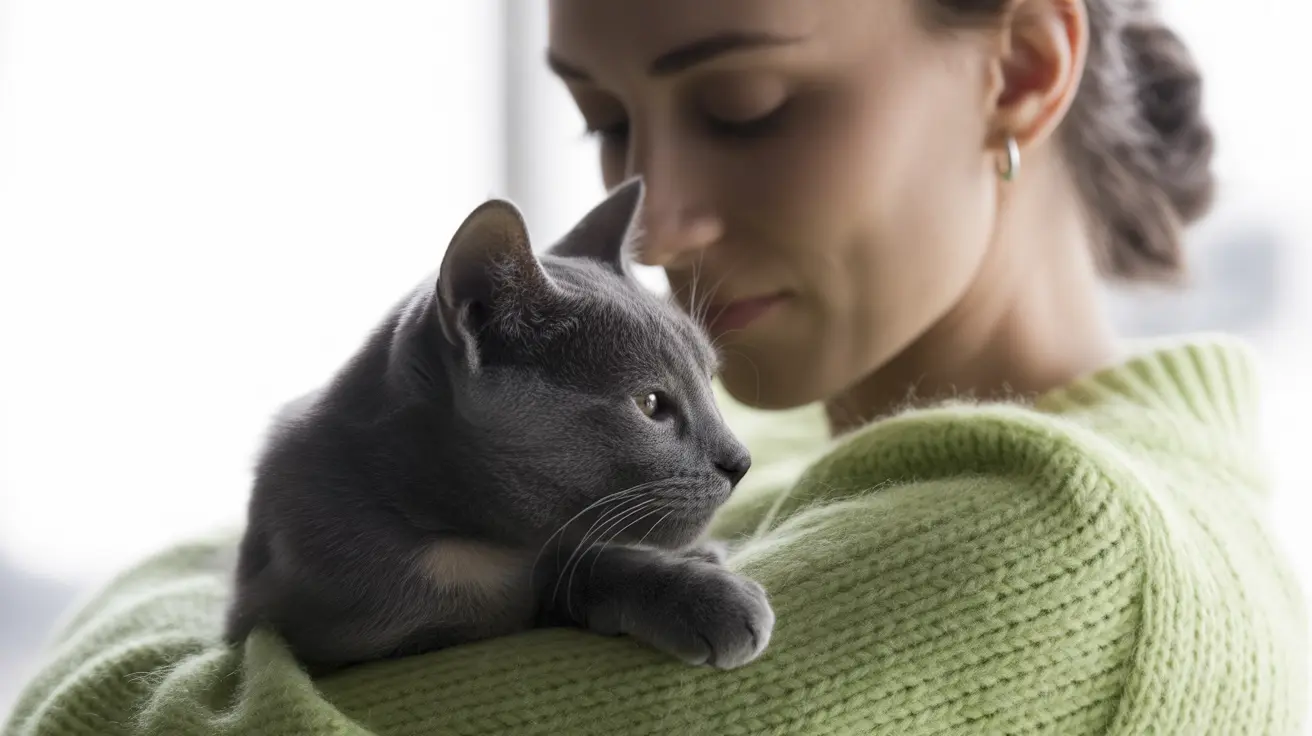Sudden Voice Changes in Dogs and Cats: When to Worry and What to Do
When your dog's familiar bark becomes hoarse or your cat's purr turns raspy, it can be concerning for any pet owner. Sudden voice changes in dogs and cats are more common than many realize and can range from temporary irritation to serious medical conditions requiring immediate attention. Unlike humans who might lose their voice from a simple cold, pets experience vocal changes due to mechanical or neurological issues affecting their larynx and vocal cords.
Understanding the underlying causes of voice changes in your furry companions is crucial for their health and well-being. While some vocal alterations may resolve on their own, others signal serious conditions that, when caught early, can be effectively treated to maintain your pet's quality of life. This comprehensive guide will help you recognize the warning signs, understand potential causes, and know when to seek professional veterinary care.
Understanding Pet Vocal Anatomy and Communication
Both dogs and cats rely heavily on vocalizations as primary communication methods with humans and other animals. Dogs use their bark to express excitement, warn of danger, seek attention, or communicate distress. The pitch, tone, and volume of your dog's bark become so familiar that any change is immediately noticeable to attentive pet owners.
Cats possess a unique anatomical feature—a special membrane that allows them to purr continuously during both inhalation and exhalation. This remarkable ability, combined with their varied meowing patterns, makes cats equally expressive vocally. When these well-established vocal patterns suddenly change, it often indicates an underlying problem affecting the larynx or surrounding structures.
Mechanical Causes of Voice Changes in Pets
Throat Trauma and Physical Injuries
Physical damage to the throat represents one of the most common causes of sudden voice changes in both dogs and cats. Interactions with other animals, falls, or impacts can cause significant injury to the delicate structures of the voice box. Dogs may paw or scratch at their neck area when experiencing throat trauma, providing an additional clue to the underlying problem.
Foreign objects pose a particularly serious threat to pet vocal health. Sticks, toys, or plastic pieces can become lodged inside the throat, damaging the voice box and potentially causing life-threatening breathing difficulties. If your pet shows signs of breathing difficulties alongside voice changes, immediate veterinary consultation is essential. Veterinarians can perform x-rays to determine the extent of damage and plan appropriate treatment.
Laryngitis and Inflammation
Laryngitis, or inflammation of the larynx (voice box), commonly affects both dogs and cats and can significantly alter their vocalizations. This condition often develops due to upper respiratory infections, inhalation of dust, smoke, or irritating gases, trauma from surgery, or excessive barking in dogs. The condition may accompany more serious infections like infectious tracheobronchitis or distemper.
Swelling and fluid buildup in the mucous membranes can obstruct airways, making this condition potentially dangerous. Brachycephalic dogs (those with flat faces), obese dogs, and dogs with existing laryngeal paralysis face higher risks of developing laryngitis from panting or overheating. Allergic reactions can also trigger the swelling that leads to vocal changes.
Tumors and Growths
Cancerous tumors can develop in the throat area, causing significant bark or meow changes in affected pets. These tumors may originate directly in the throat or spread from other areas of the body. Common types affecting the larynx include laryngeal chondrosarcoma and various other throat tumors that can obstruct normal vocal cord function.
A veterinarian will conduct comprehensive tests and x-rays to diagnose the type and extent of any cancerous growths. Treatment options vary significantly depending on factors such as tumor size, degree of spread, the pet's breed, age, and how early the condition is detected. While cancer is serious, many treatment approaches focus on keeping the pet comfortable and pain-free while addressing the underlying condition.
Neurological Causes of Voice Changes
Laryngeal Paralysis
Laryngeal paralysis occurs when nerve signals to the vocal cords become impaired, preventing normal vocal cord movement and vibration. This neurological condition can be breed-specific, with certain dog breeds showing genetic predisposition to developing paralysis over time. The condition affects the muscles that control the opening and closing of the larynx, leading to characteristic voice changes and potential breathing difficulties.
Dogs with laryngeal paralysis often exhibit a deeper, rougher voice or may lose their voice entirely. The condition frequently worsens over time and may be accompanied by increased panting, exercise intolerance, and respiratory distress, particularly in warm weather or during physical activity.
Hormonal and Metabolic Conditions
Hypothyroidism represents a significant cause of voice changes in dogs, occurring when the thyroid glands fail to produce adequate hormones needed to regulate metabolism. Dogs with hypothyroidism typically develop a hoarse or weak bark, often accompanied by other symptoms such as hair loss, flaky skin, weight gain, and lethargy.
Veterinarians diagnose hypothyroidism through comprehensive blood work that measures thyroid hormone levels. Treatment typically includes thyroid hormone replacement medication and sometimes steroids to help repair voice box function. With proper medical care and consistent treatment, success rates for managing hypothyroidism are generally high.
In cats, hyperthyroidism can also affect vocalization patterns, often causing increased vocalization rather than voice loss, though changes in voice quality may still occur alongside the more typical symptoms of weight loss, increased appetite, and restlessness.
Neuromuscular Diseases
Several neuromuscular diseases can affect pet vocalizations by impacting the muscles and nerves that control the larynx. Myasthenia gravis, a condition affecting nerve-muscle communication, can cause voice changes along with other symptoms like difficulty swallowing, fatigue, and muscle weakness. Masticatory myositis, which affects the muscles used for chewing, can also impact nearby structures involved in vocalization.
Degenerative myelopathy, while primarily affecting spinal cord function, can sometimes influence the nerves controlling the larynx in advanced cases. These conditions require specialized veterinary diagnosis and management approaches tailored to each pet's specific situation.
Recognizing When to Seek Veterinary Care
Emergency Warning Signs
Certain symptoms accompanying voice changes require immediate emergency veterinary attention. If your pet develops bluish gums, increased pulse rate, slower respiratory rate, or high body temperature alongside voice changes, these signs indicate potential airway obstruction that could be life-threatening. Untreated airway obstruction may lead to collapse and requires emergency intervention.
Sudden allergic reactions causing rapid onset of breathing difficulties and voice changes also constitute veterinary emergencies. Any pet showing signs of severe respiratory distress, open-mouth breathing in cats, or complete inability to vocalize should receive immediate professional care.
Non-Emergency But Concerning Signs
Voice changes lasting more than a single day warrant veterinary evaluation, even if your pet seems otherwise comfortable. Additional symptoms that should prompt a veterinary visit include persistent coughing (either dry or productive), difficulty swallowing, increased panting, bad breath, decreased energy levels, and any discharge from the nose or mouth.
Changes in eating habits, reduced exercise tolerance, or behavioral changes alongside vocal alterations may indicate underlying conditions that benefit from early intervention. The sooner these conditions are diagnosed and treated, the better the potential outcomes for your pet's long-term health and comfort.
Diagnostic Process and Veterinary Examination
Initial Assessment
When you bring your pet to the veterinarian for voice changes, the diagnostic process typically begins with a comprehensive history and physical examination. Your veterinarian will want to know when the voice changes first appeared, any potential triggering events, associated symptoms, and whether the changes are getting worse, better, or staying the same.
The physical examination includes careful palpation of the throat and neck area, listening to breathing sounds, and observing your pet's respiratory pattern. Your veterinarian may also examine the oral cavity to look for obvious foreign objects, inflammation, or other abnormalities that might explain the vocal changes.
Advanced Diagnostic Testing
Depending on initial findings, your veterinarian may recommend additional diagnostic tests. Endoscopy under anesthesia allows direct visualization of the larynx and vocal cords, helping identify structural abnormalities, paralysis, or foreign objects. This procedure provides detailed information about the condition of the voice box and surrounding tissues.
Blood work may be necessary to check for conditions like hypothyroidism in dogs or hyperthyroidism in cats. X-rays can reveal tumors, foreign objects, or other structural problems affecting the throat and chest area. In some cases, more specialized imaging like CT scans or MRI may be recommended for complex cases.
Treatment Approaches and Management
Medical Management
Treatment for voice changes varies dramatically depending on the underlying cause. Inflammatory conditions like laryngitis often respond well to corticosteroids or non-steroidal anti-inflammatory drugs (NSAIDs) to reduce swelling. Diuretics may be used when fluid buildup contributes to the problem, while pain relief medications help manage discomfort.
Bacterial infections require appropriate antibiotic therapy, while viral infections typically receive supportive care including humidified air, soft diets, and environmental modifications to avoid dust and other irritants. Cough suppressants may provide relief for pets with persistent, uncomfortable coughing associated with their voice changes.
Surgical Interventions
Some conditions affecting pet voices require surgical treatment. Foreign objects lodged in the throat must be surgically removed, often requiring emergency intervention. Tumors may be surgically excised when feasible, depending on their location, size, and type.
In severe cases of airway obstruction, emergency tracheotomy may be necessary to maintain breathing while addressing the underlying cause. For dogs with laryngeal paralysis, surgical procedures can help improve airway function, though they may not restore normal voice quality.
Supportive Care and Home Management
Home care plays an important role in supporting pets with voice changes. Maintaining a humidified environment helps soothe irritated throat tissues, while providing soft, easy-to-swallow foods reduces strain on the throat during eating. Avoiding exposure to smoke, dust, and other environmental irritants supports healing and prevents further damage.
For cats with laryngitis, cleaning nasal and eye discharge helps maintain comfort, while immune support through proper nutrition and supplements may aid recovery. Ensuring your pet stays hydrated and gets adequate rest supports the natural healing process.
Prevention Strategies for Pet Vocal Health
Environmental Management
Preventing voice changes in pets often involves managing their environment to reduce risk factors. Keep small objects that could be swallowed away from pets, maintain clean living spaces to reduce infection risk, and avoid exposing pets to cigarette smoke or other respiratory irritants.
Regular veterinary checkups help detect developing problems early, while maintaining current vaccinations protects against viral infections that commonly cause laryngitis in both dogs and cats. For dogs prone to excessive barking, proper training and environmental enrichment can prevent voice strain from overuse.
Breed-Specific Considerations
Certain breeds face higher risks for specific voice-related conditions. Brachycephalic breeds (flat-faced dogs and cats) require special attention to prevent respiratory complications that can affect their voice. Large breed dogs may be more prone to laryngeal paralysis, making regular monitoring especially important as they age.
Understanding your pet's breed-specific predispositions allows for more targeted preventive care and earlier recognition of developing problems. Discuss these risks with your veterinarian to develop an appropriate monitoring and prevention strategy for your individual pet.
Managing Excessive Barking and Voice Strain
Understanding the Root Causes
Excessive barking in dogs often stems from boredom, stress, anxiety, or territorial behavior rather than medical issues. However, chronic excessive barking can lead to voice strain and laryngeal edema (swelling of vocal fold tissues), potentially causing temporary voice loss or changes.
Identifying and addressing the underlying behavioral causes of excessive barking helps prevent voice-related complications while improving your dog's overall well-being. Environmental enrichment, adequate exercise, and mental stimulation can significantly reduce problematic barking behaviors.
Training and Behavioral Management
Effective management of excessive barking requires avoiding unintentional reinforcement of the behavior. Many pet owners inadvertently reward barking by providing attention, even negative attention, when their dog vocalizes excessively. Consistent training approaches that reward quiet behavior while ignoring inappropriate barking tend to be most successful.
Professional dog trainers or veterinary behaviorists can provide specialized guidance for persistent barking problems that might lead to voice strain. Early intervention with behavioral issues prevents the development of voice problems related to overuse.
Recovery and Long-Term Prognosis
Factors Affecting Recovery
The prognosis for pets with voice changes varies significantly depending on the underlying cause, severity of the condition, and how quickly treatment begins. Many causes of voice changes are treatable, and early intervention often leads to complete recovery of normal vocal function.
Recovery time depends on the specific condition and its severity. Mild laryngitis may resolve within days to weeks with appropriate treatment, while more serious conditions like tumors or laryngeal paralysis may require ongoing management. Some voice changes can become permanent if conditions go untreated for extended periods.
Most pets adapt well to voice changes and can maintain excellent quality of life even with altered vocalizations. The key is ensuring any underlying medical conditions receive appropriate treatment to prevent progression and complications.
Frequently Asked Questions
- Can dogs permanently lose their voice from excessive barking?
Dogs can temporarily lose their voice from excessive barking due to laryngeal edema (swelling of vocal fold tissues), but permanent voice loss from barking alone is rare. The voice typically returns after the swelling subsides and the throat tissues heal, unless there is permanent damage from other underlying conditions.
- How can I tell if my cat's voice change is serious?
Serious voice changes in cats are typically accompanied by other symptoms like difficulty breathing, loss of appetite, lethargy, changes in grooming habits, or breathing difficulties. Persistent voice changes lasting more than a day or two, especially with these additional symptoms, warrant veterinary evaluation.
- What should I do if my pet suddenly can't bark or meow at all?
Complete loss of voice, especially when sudden, requires prompt veterinary attention. This could indicate airway obstruction, severe inflammation, or other serious conditions. If accompanied by breathing difficulties, bluish gums, or distress, seek emergency veterinary care immediately.
- Are certain dog breeds more prone to voice problems?
Yes, brachycephalic breeds (flat-faced dogs) are more prone to respiratory and voice issues due to their anatomy. Large breeds may be more susceptible to laryngeal paralysis, while dogs with existing respiratory conditions face higher risks for voice-related complications.
- Can environmental factors cause voice changes in pets?
Environmental factors like smoke, dust, allergens, temperature extremes, and irritating gases can contribute to voice changes by causing inflammation or irritation of the larynx and throat tissues. Maintaining a clean, smoke-free environment helps prevent many voice-related problems.
- How long does it typically take for pet voice changes to resolve?
Recovery time varies greatly depending on the underlying cause. Simple laryngitis may resolve in a few days to weeks with treatment, while more serious conditions like tumors or neurological issues may require longer-term management. Early diagnosis and treatment generally improve recovery times and outcomes.
- When should I consider voice changes in my pet an emergency?
Voice changes become emergencies when accompanied by severe breathing difficulties, bluish gums, open-mouth breathing in cats, complete inability to breathe normally, or signs of airway obstruction. Sudden onset of these symptoms requires immediate emergency veterinary care.
Conclusion
Sudden voice changes in dogs and cats serve as important indicators of underlying health conditions that range from minor irritations to serious medical emergencies. While not all voice changes represent cause for alarm, understanding the potential causes—from mechanical issues like throat trauma and tumors to neurological conditions like laryngeal paralysis—helps pet owners make informed decisions about their pets' care.
The key to successful management lies in recognizing when voice changes warrant professional veterinary attention and acting promptly to address underlying conditions. With proper diagnosis and treatment, many causes of voice changes in pets are highly treatable, allowing your furry companions to maintain their quality of life and continue their important vocal communications with you and their environment. Remember that early intervention often provides the best outcomes, making your vigilant observation and quick response crucial components of your pet's vocal health care.






